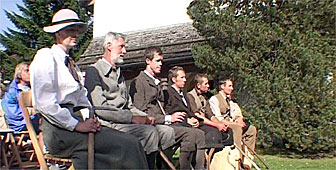Fresh snow forces team to abandon assault on Wetterhorn

Fresh snowfall on the Wetterhorn at 3,701 metres above sea level forced swissinfo's seven-member team of British climbers and Swiss guides to abandon its planned ascent to the peak on the eighth leg of a ten-day mountain expedition.
Though unable to make an assault on the mountain themselves, the group did take the opportunity to recall the day in 1854 when an ascent of the Wetterhorn started what was to become the golden age of mountaineering.
One of the team members had more reason than most to recall the past as the sun rose above the Gleckstein Hut.
Razor in hand, Philip Martineau headed below the hut in the early morning sunlight to shave in a stream close to the very spot where his distant relative, Sir Alfred Wills, had taken an icy bath on September 17th, 1854, before climbing the Wetterhorn.
“I think he was very uncomfortable during the night and a bit unhappy about the meal he had eaten in the evening, which was mutton with too much garlic for his taste,” said Martineau.
“So he got up early in the morning, eager to be going, and took a bath in an icy cold stream,” he added.
Wills slept under a boulder before his ascent, whereas Martineau enjoyed the comforts of the Gleckstein Hut.
Although the British climber has ascended the Wetterhorn once before, he may have given up the modest luxury of the mountain hut if it meant he could have taken on the mountain again.
“The conditions are not suitable for going up the Wills Ridge [to the summit] because it could be quite nasty,” Martineau said while climbing a minor peak, the Chrinnenhorn, 1,000 metres below the Wetterhorn summit.
Ascent small consolation
The ascent was small consolation, however, for having missed out on the chance to climb the Wetterhorn.
“I’m disappointed because it would have brought the expedition to a climax,” Martineau said.
“But I’ll live to climb another day and [the mountain] is not going anywhere.”
Wills’ published account of his Wetterhorn ascent and further intrepid Alpine adventures helped more than any other writing of the time to popularise mountaineering.
Johann Kaufmann, one of the Alps Walk team’s mountain guides, said he was impressed by the observations Wills made at the time, which contributed to the development of mountaineering equipment.
“He wrote a lot about the differences in equipment used by the guides of Grindelwald and Chamonix,” remarked Kaufmann.
“For example, the Grindelwald guides had excellent ice-axes, while their counterparts in Chamonix had better crampons.”
As the team trudged back down from the Chrinnenhorn through the snow, they caught a fleeting glimpse of an ibex crossing the path in front of them.
After two days of rain and snowfall, the trail afforded spectacular vistas of such 4,000 metre peaks as the Schreckhorn as well as the verdant valley of Grindelwald down below.
Memorial service held
The team rounded off the day at a church just above the centre of Grindelwald, where more than 100 people had gathered for a service of remembrance in honour of all the climbers and mountain guides who have lost their lives in the Alps.
Outside the church, the expedition members spent a few minutes strolling around the cemetery, which commands a stunning view of the Fiescher Glacier and Fiescherhorn, glistening in the distance.
“My first impression of the cemetery was of how wonderfully it is kept, spick and span with so many flowers,” Martineau said, “but then you look at the life spans of the people there and think ‘If I could live to be 85 as well, then I’d consider myself lucky'”.
“So I think one should give thanks for the intensity with which some of these people lived their lives in the mountains,” he added.
Among those pioneering mountaineers buried at the cemetery is the legendary 19th century climber and Alpine historian, W A B Coolidge, who died in Grindelwald in 1926 at the age of 76.
His headstone reads simply: “At his own request, buried amongst the mountains he loved so well.”
swissinfo

In compliance with the JTI standards
More: SWI swissinfo.ch certified by the Journalism Trust Initiative
You can find an overview of ongoing debates with our journalists here. Please join us!
If you want to start a conversation about a topic raised in this article or want to report factual errors, email us at english@swissinfo.ch.